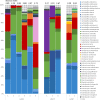Bacterial community dynamics in lait caillé, a traditional product of spontaneous fermentation from Senegal
- PMID: 31075124
- PMCID: PMC6510411
- DOI: 10.1371/journal.pone.0215658
Bacterial community dynamics in lait caillé, a traditional product of spontaneous fermentation from Senegal
Abstract
Spontaneously fermented food products contain a complex, natural microbial community with potential probiotic activity. The addition of a health-promoting, probiotic bacterium to these products ensures the delivery of that probiotic activity to consumers. Here, we assess the microbial community of a traditional Senegalese milk product produced by spontaneous fermentation, called lait caillé. We produced the lait caillé in a traditional way and added a probiotic starter containing Lactobacillus rhamnosus yoba 2012 to the traditional process. We found various species that are known for their ability to ferment milk, including species from the genera Lactobacillus, Acetobacter, Lactococcus, and Streptococcus. Our results show that the addition of L. rhamnosus to the inoculum, can result in detectable levels of this strain in the final product, ranging between 0.2 and 1 percent of the total bacterial population. Subsequent rounds of fermentation using passive back-slopping without the addition of new L. rhamnosus led to a loss of this strain from the community of fermenting bacteria. Our results suggest that the addition of probiotic strains at every fermentation cycle can enrich the existing complex communities of traditionally fermented lait caillé while traditional bacterial strains remain dominant in the bacterial communities.
Conflict of interest statement
RK is founder of the Yoba for Life foundation (2009), a non-profit organization, accredited by the Dutch Tax Authorities as a Public Benevolent Institution (PBI), which aims to promote local production and consumption of fermented products in Africa. African fermented products made with the Yoba starter culture are not marketed by the foundation as such, but the Yoba for Life foundation stimulates local production and ownership, allowing income-generating activities for African small-scale entrepreneurs in the food sector. The Yoba for Life foundation distributes and sells ready-to-use sachets with dried bacterial starter cultures at cost price, through a network of partners and volunteers to facilitate the local production of dairy and cereal-based products by controlled bacterial fermentation. The Yoba starter culture contains L. rhamnosus yoba 2012, which is the generic variant of L. rhamnosus GG. The remaining authors declare that the research was conducted in the absence of any commercial or financial relationships that could be construed as a potential conflict of interest. This does not alter our adherence to PLOS ONE policies on sharing data and materials.
Figures






References
-
- Gning MC. Trade, political influence and liberalization: situating the poor in the political economy of livestock in Senegal. PPLPI Work Pap—Pro-Poor Livest Policy Initiat FAO. 2004;(8):38.
Publication types
MeSH terms
LinkOut - more resources
Full Text Sources

